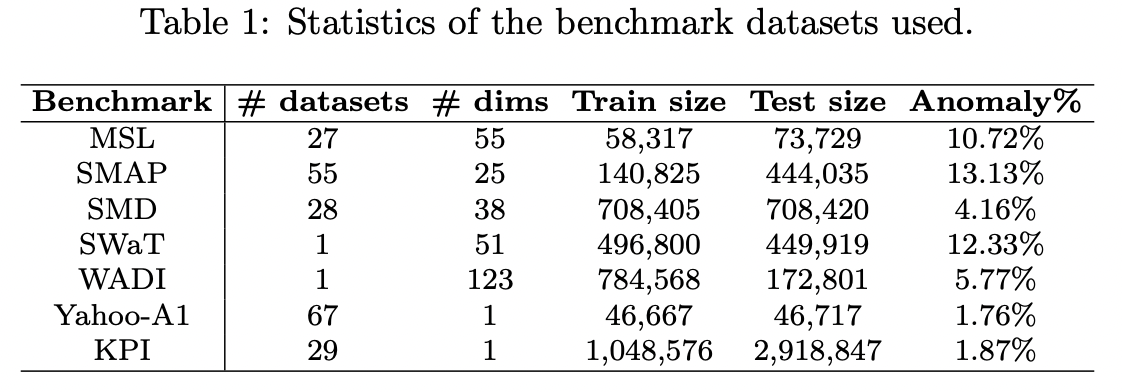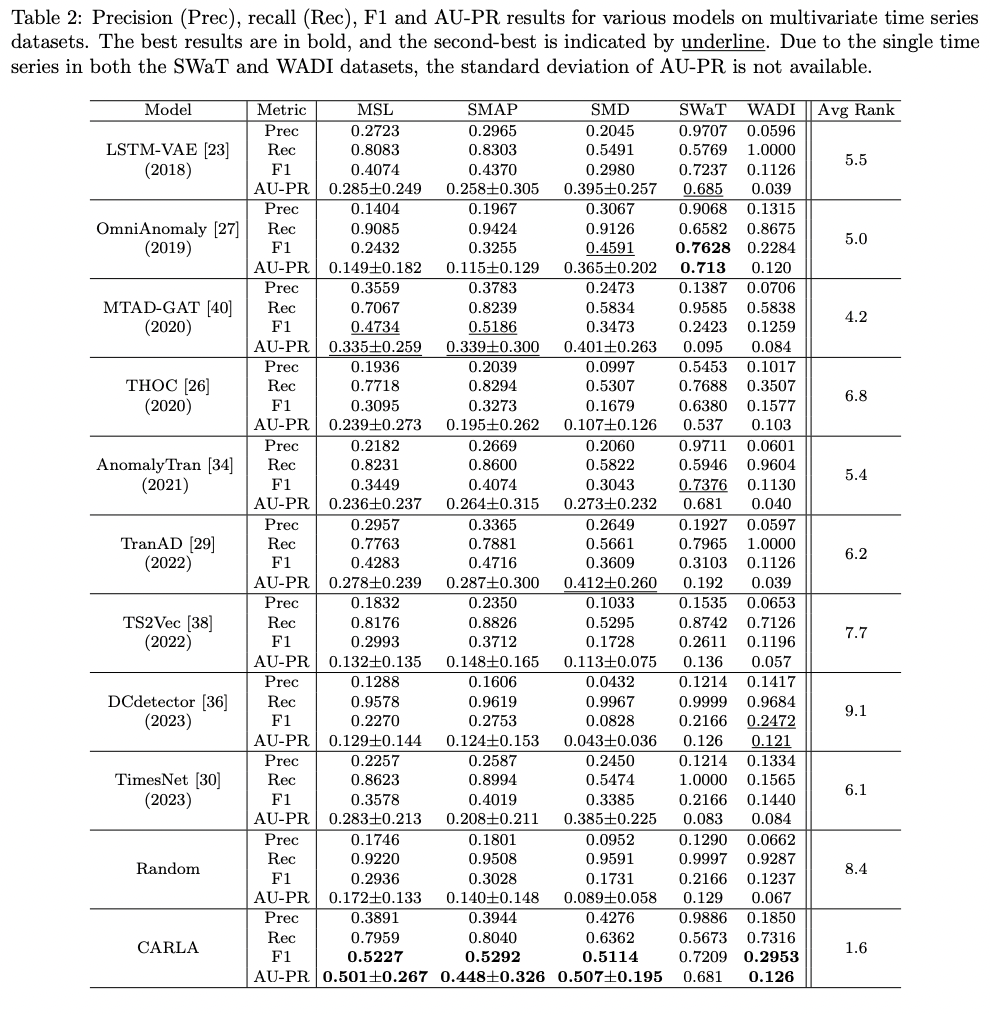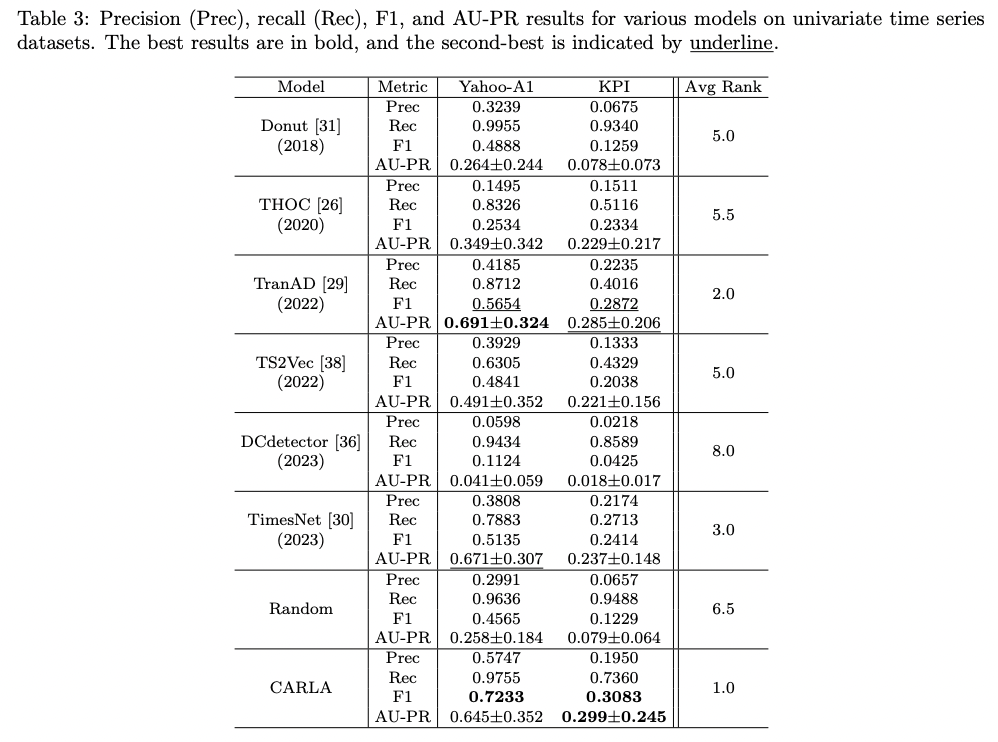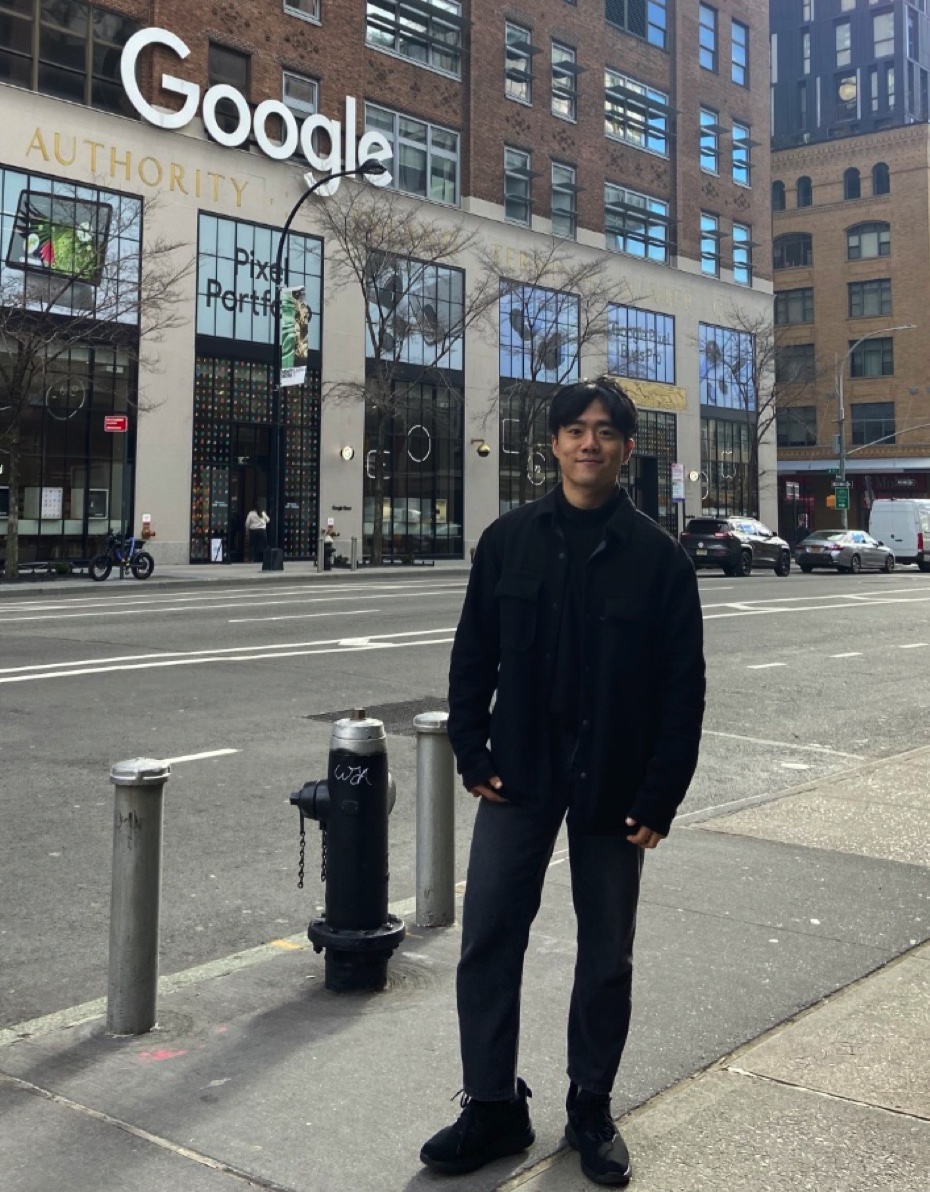CARLA: Self-supervised Contrastive Representation Learning for Time Series Anomaly Detection
https://arxiv.org/pdf/2306.15489
Contents
- Abstract
- Introduction
- CARLA
- Overview
- Problem Definition
- Stage 1: Pretext Stage
- Stage 2: Self-supervised Classficaiton Stage
- Inference
- Experiments
Abstract
CARLA = CL for TSAD
Existing CL methods
- Assume that augmented TS windows are positive samples
- Assume that temporally distant TS windows are negative samples
\(\rightarrow\) Argue that these assumptions are limited!!!
\(\because\) Augmentation can transform them to negative samples!
1. Introduction
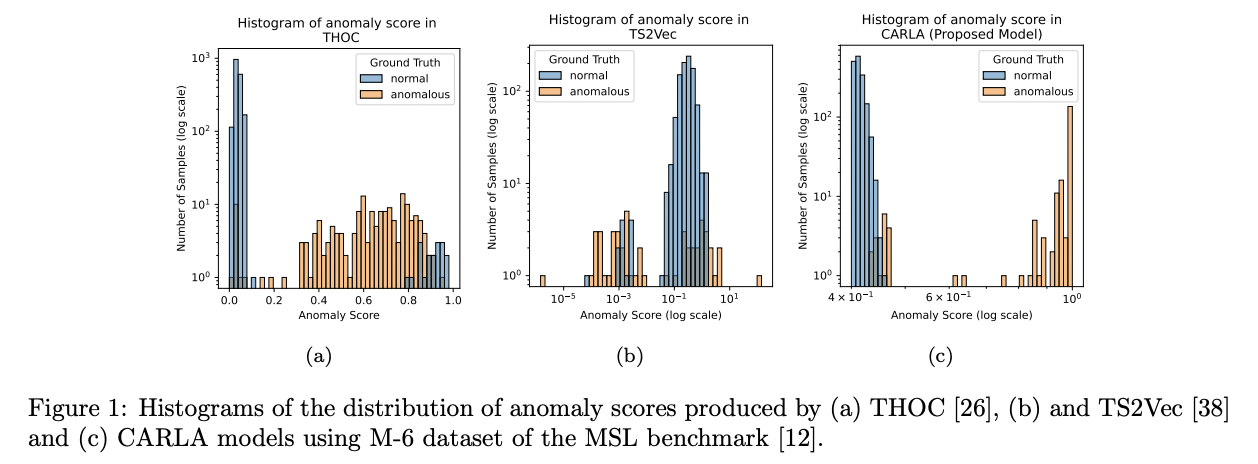
Contribution
- [1] Novel CL model to detect anomalies in TS
- Both UTS & MTS
- Learns to effectively discriminate anomalous ones in the feature space
- Code: https: //github.com/zamanzadeh/CARLA
- [2] Effective CL method for TSAD
- To learn feature representations for a pretext task
- By leveraging existing generic knowledge about TS anomalies
- To learn feature representations for a pretext task
- [3] Self-supervised classification method
- Classify TS windows
- Goal: Classify each sample by utilising its neighbours in the representation space
- Representation space: Learned in the pretext stage
- [4] Experiments
- Seven real-world benchmark datasets
- vs. 10 SOTA unsupervised, semi-supervised, and self-supervised contrastive learning models.
2. CARLA
(1) Overview
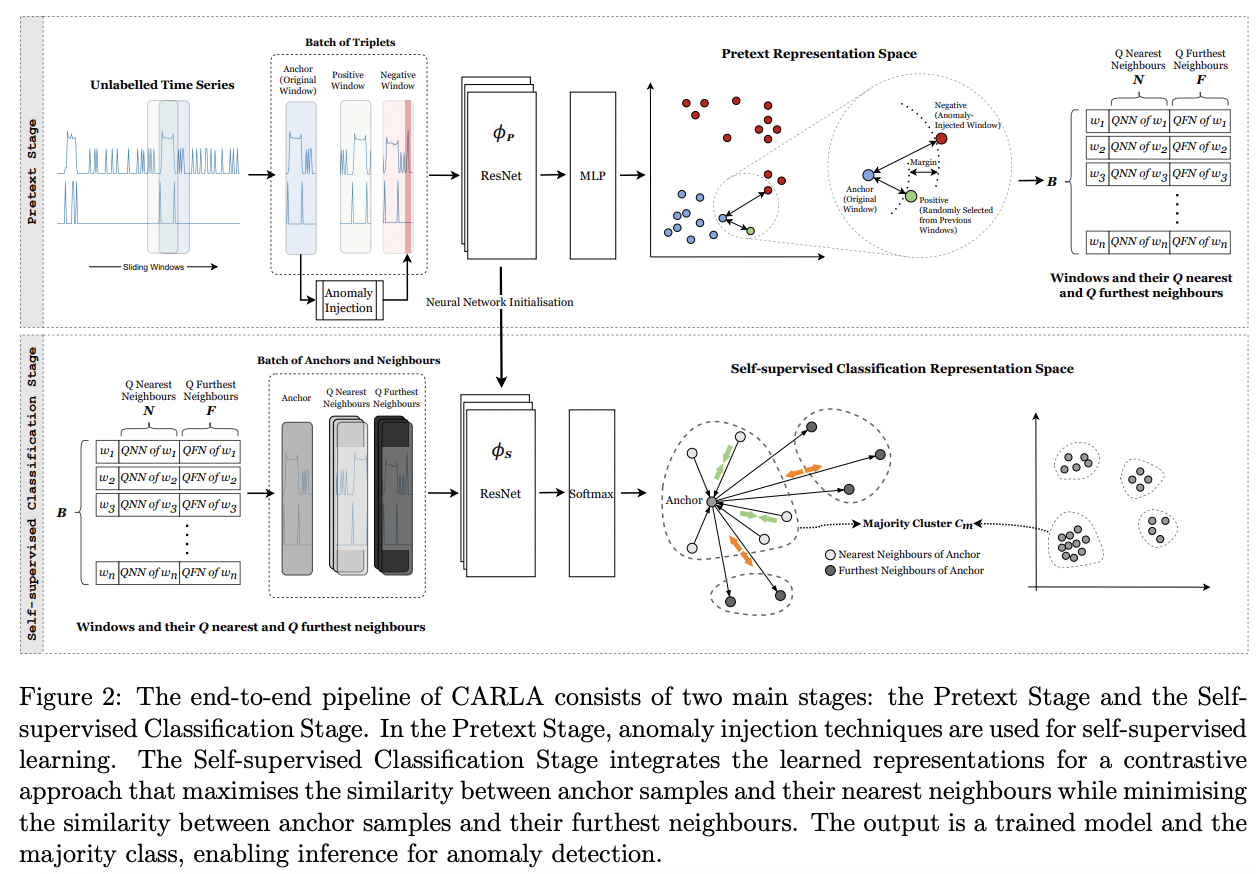
(2) Problem Definition
Time series \(\mathcal{D}\) : Partitioned into \(m\) overlapping windows \(\left\{w_1, \ldots, w_i, \ldots, w_m\right\}\)
- with stride 1 where \(w_i=\left\{x_1, \ldots, x_i, \ldots, x_{W S}\right\}\),
- WS = TS window size
- \[x_i \in \mathbb{R}^{\text {Dim }}\]
CARLA: Built on several key components
Consists of two main stages
-
Stage 1) Pretext Stage
-
Stage 2) Self-supervised Classification Stage.
(3) Stage 1: Pretext Stage
Employs anomaly injection: To learn ..
- (1) Similar representations for temporally proximate windows
- (2) Distinct representations for anomalous windows
Anomaly injection
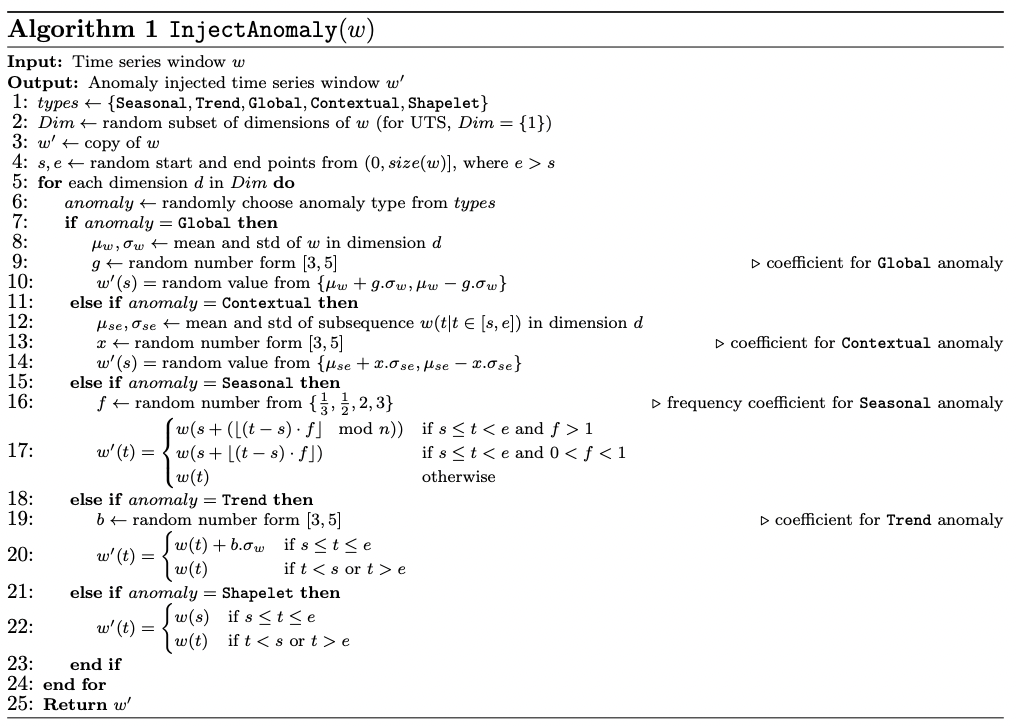
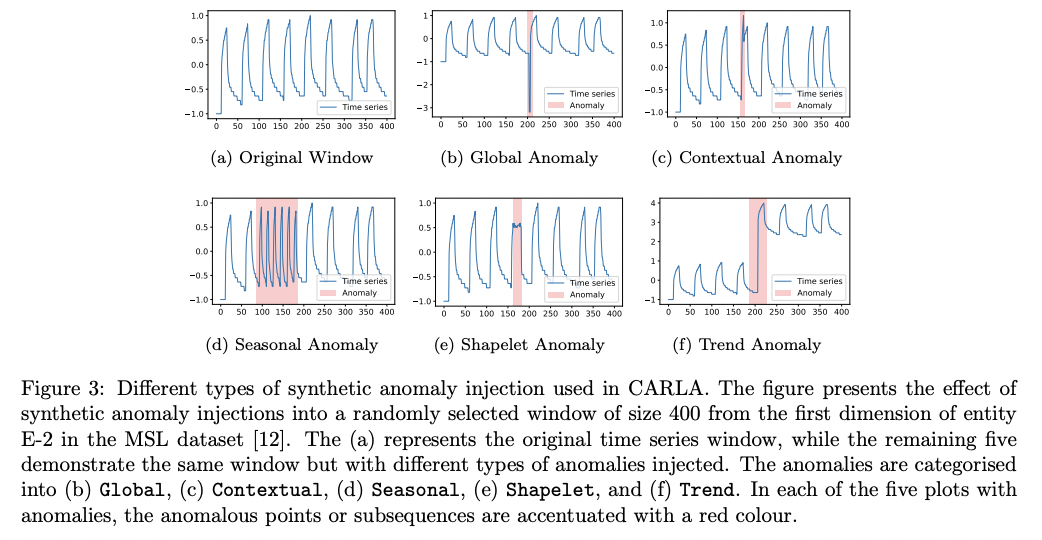
Stage 1-1) Contrastive Representation Learning
- \(\mathcal{L}_{\text {Pretext }}\left(\phi_p, \mathcal{T}, \alpha\right)=\frac{1}{\mid \mathcal{T}\mid } \sum_{(\alpha, p, n) \in \mathcal{T}} \max \left(\mid \phi_p(a)-\phi_p(p)\mid _2^2-\mid \phi_p(a)-\phi_p(n)\mid _2^2+\alpha, 0\right)\).
Stage 1-2) Nearest and Furtherest Neighbours
- For each sample, identify semantically meaningful nearest & furthest neighbours
- Based on the representation space obtained in Stage 1-1)
Pseudocode
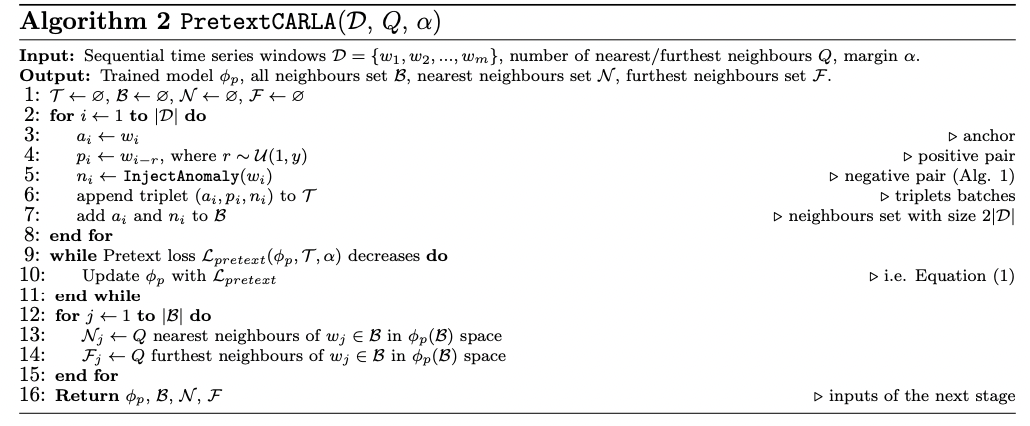
Result: Establish a prior by finding the nearest and furthest neighbours for each window representation for the next stage!
(4) Stage 2: Self-supervised Classification Stage
Classifies these window representations as normal or anomalous!
\(\rightarrow\) Based on the proximity of their neighbours in the representation space
Notation
- Classes \(\mathcal{C}=\{1, \ldots, C\}\)
- Model \(\phi_s(w) \in[0,1]^c\).
**Pairwise similarity **
-
Between the probability distributions of the anchor and its neighbours
-
\(\text { similarity }\left(\phi_s, w_i, w_j\right)=\left\langle\phi_s\left(w_i\right) \cdot \phi_s\left(w_j\right)\right\rangle=\phi_s\left(w_i\right)^{\top} \phi_s\left(w_j\right)\).
Loss 1) Consistency loss
- Binary CE loss
-
Maximise the similarity between the anchor and nearest neighbours
- \(\mathcal{L}_{\text {consistency }}\left(\phi_s, \mathcal{B}, \mathcal{N}\right)=-\frac{1}{\mid \mathcal{B}\mid } \sum_{w \in \mathcal{B}} \sum_{w_s \in \mathcal{N}_w} \log \left(\text { similarity }\left(\phi_s, w, w_n\right)\right)\).
Loss 2) Inconsistency loss
- \(\mathcal{L}_{\text {inconsistency }}\left(\phi_s, \mathcal{B}, \mathcal{F}\right)=-\frac{1}{\mid \mathcal{B}\mid } \sum_{w \in \mathcal{B}} \sum_{w_n \in \mathcal{F}_w} \log \left(\operatorname{similarity}\left(\phi_s, w, w_n\right)\right)\).
Loss 3) Entropy loss
- To encourage class diversity and prevent overfitting
- Entropy on the distribution of anchor and neighbour samples across classes.
- \(\mathcal{L}_{\text {entropy }}\left(\phi_s, \mathcal{B}, \mathcal{C}\right)=\sum_{c \in \mathcal{C}} \dot{\phi}_g \log \left(\dot{\phi}_g\right) \text { where } \dot{\phi}_g^c=\frac{1}{\mid \mathcal{B}\mid } \sum_{w_i \in \mathcal{B}} \phi_g^c\left(w_i\right)\).
- \(\phi_s^c\left(w_i\right)\): Probability of window \(w_i\) being assigned to class \(c\)
Final loss function:
\(\begin{aligned} & \mathcal{C}_{\text {Sedf-mpervised }}\left(\phi_{,}, B, N, \mathcal{F}, \mathcal{C}, \beta\right)= \\ & \mathcal{L}_{\text {emsustency }}\left(\phi_n, \mathcal{B}, \mathcal{N}\right)-\mathcal{L}_{\text {internstatery }}\left(\phi_n, \mathcal{B}, \mathcal{F}\right)-\beta \cdot \mathcal{L}_{\text {entropy }}\left(\phi_n, \mathcal{B}, C\right) \end{aligned}\).
Pseudocode
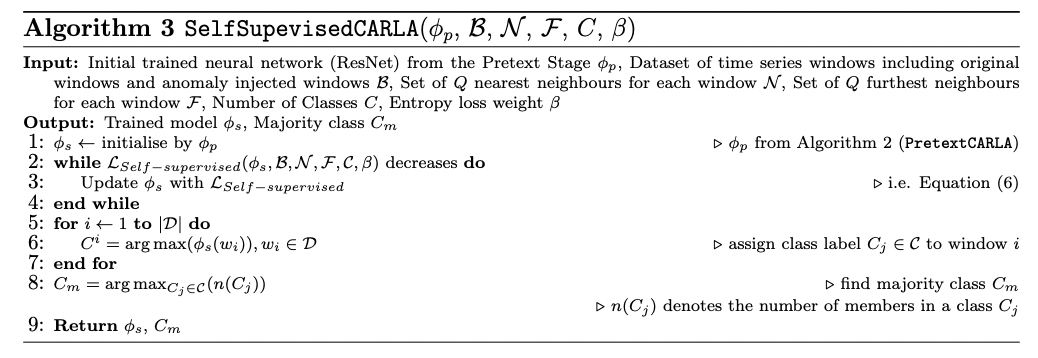
(5) Inference
Determine the class assignments for set \(\mathcal{D}\) and majority class \(C_{\mathrm{m}}\),
\(\rightarrow\) \(C_{\mathrm{m}}=\arg \max _{C_j \in c}\left(n\left(C_j\right)\right)\)
For every new window \(w_i\) …
- Calculate \(\phi_0^{C-}\left(w_t\right)\)
- Probability of \(w_T\) being assigned to the majority class \(C_m\).
- Class \(w_l\) as normal / anomalous based on whether it belongs to the majority class
Anomaly label & score
\(\text { Anomaly label }\left(w_i\right): \begin{cases}0, & \text { if } \forall c \in \mathcal{C}, \phi_i^C=m\left(w_i\right) \geq \phi_i^C\left(w_i\right) \\ 1, & \text { otherwise }\end{cases}\).
\(\text { Anomaly score }\left(w_t\right)=1-\phi_g^{C-}\left(w_t\right)\).
3. Experiments
